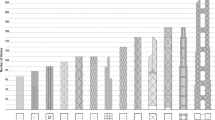Abstract
Background
Excessive vibrations induced by trains and amplified or propagated through the ground can affect sensitive areas such as hospitals, residences, or telecommunication buildings. However, it has been found that the control of these vibrations can be improved by including materials with a high level of damping between the adjacent ground and the tunnel structure.
Review factor
In this study, the behavior of a new type of mortar called C-COM has been characterized through finite element simulations, and its effectiveness on mitigating vibrations in a tunnel is determined.
Conclusions
Five parameters have been proposed to compare the response obtained with the new mortar and the one corresponding to a model with conventional materials. It was found that, using the C-COM mortar, vibration levels can be reduced by 10–20%.











Similar content being viewed by others
References
Yang Y-B, Hung HH (2009) Wave propagation for train-induced vibrations: a finite/infinite element approach. World Scientific, Singapore
Yang J et al (2019) Prediction and mitigation of train-induced vibrations of large-scale building constructed on subway tunnel. Sci Total Environ 668:485–499
Forrest JA, Hunt HEM (2006) A three-dimensional tunnel model for calculation of train-induced ground vibration. J Sound Vib 294(4–5):678–705
Ma M, Markine V, Liu W, Yuan Y, Zhang F (2011) Metro train-induced vibrations on historic buildings in Chengdu, China. J Zhejiang Univ A 12(10):782–793
Zou C, Wang Y, Moore JA, Sanayei M (2017) Train-induced field vibration measurements of ground and over-track buildings. Sci Total Environ 575:1339–1351
Eitzenberger A (2008) Train-induced vibrations in tunnels: a review. Luleåtekniska universitet. https://www.diva-portal.org/smash/get/diva2:996052/FULLTEXT01.pdf
Rosell EC, Herraiz JR, Llario FR, Canales C, Palomo ML, Bru AS (2020) Development of a flexible grout (C-COM) for precast concrete structural support filling in tunnel boring machine excavations. In: 8th international conference of the Spanish association for structural engineering (ACHE), pp 1–7
Najim KB, Hall MR (2012) Mechanical and dynamic properties of self-compacting crumb rubber modified concrete. Constr Build Mater 27(1):521–530
Li Z, Li F, Li JSL (1998) Properties of concrete incorporating rubber tyre particles. Mag Concr Res 50(4):297–304
Güneyisi E, Gesouglu M, Özturan T (2004) Properties of rubberized concretes containing silica fume. Cem Concr Res 34(12):2309–2317
Turatsinze A, Bonnet S, Granju J-L (2007) Potential of rubber aggregates to modify properties of cement based-mortars: improvement in cracking shrinkage resistance. Constr Build Mater 21(1):176–181
Eldin NN, Senouci AB (1993) Observations on rubberized concrete behavior. Cem Concr Aggregates 15(1):74–84
Avcular N et al (1997) Analysis of rubberized concrete as a composite material. Cem Concr Res 27(8):1135–1139
Eldin NN, Senouci AB (1993) Rubber-tire particles as concrete aggregate. J Mater Civ Eng 5(4):478–496
Toutanji HA (1996) The use of rubber tire particles in concrete to replace mineral aggregates. Cem Concr Compos 18(2):135–139
Ghaly AM, Cahill JD IV (2005) Correlation of strength, rubber content, and water to cement ratio in rubberized concrete. Can J Civ Eng 32(6):1075–1081
Gardien W, Stuit HG (2003) Modelling of soil vibrations from railway tunnels. J Sound Vib 267(3):605–619
Liu J, Li B (2005) A unified viscous-spring artificial boundary for 3-D static and dynamic applications. Sci China Ser E Eng Mater Sci 48(5):570–584
de Fomento M (1999) Recomendaciones para el proyecto de plataformas ferroviarias. In: Servicio de Publicaciones del Ministerio de Fomento. Spanish Ministry of Development Madrid
Labrado-Palomo M, Roca-Barceló F, Ribes-Llario F, Real-Herráiz J (2018) Effect of vehicle speed on the dynamics of track transitions. J Vib Control 24(21):5118–5128
Yang LA, Powrie W, Priest JA (2009) Dynamic stress analysis of a ballasted railway track bed during train passage. J Geotech Geoenviron Eng 135(5):680–689
Jenkins HH, Stephenson JE, Clayton GA, Morland GW, Lyon D (1974) The effect of track and vehicle parameters on wheel/rail vertical dynamic forces. Railw Eng J 3:1
Lei X (2017) High speed railway track dynamics. Springer, Berlin
Melis M (2008) Apuntes de introducción a la dinámica vertical de la vía y a las señales digitales en ferrocarriles. In: Univ. Politécnica Madrid—Cátedra Ferrocarriles, Madrid, p 797
Arias A (1970) A measure of earthquake intensity. In: Seismic design for nuclear power plants, pp 438–483
Bradley BA (2015) Correlation of arias intensity with amplitude, duration and cumulative intensity measures. Soil Dyn Earthq Eng 78:89–98
Greer R, Manning C (1998) Vibration isolation for railways. Acoust Bull 23:13–17
Heckl M, Hauck G, Wettschureck R (1996) Structure-borne sound and vibration from rail traffic. J Sound Vib 193(1):175–184
Author information
Authors and Affiliations
Corresponding author
Ethics declarations
Conflict of interest
On behalf of all authors, the corresponding author states that there is no conflict of interest.
Additional information
Publisher's Note
Springer Nature remains neutral with regard to jurisdictional claims in published maps and institutional affiliations.
Rights and permissions
About this article
Cite this article
Colomer Rosell, E.A., Alcañiz Martínez, J.H., Femenía Quiles, R. et al. Mitigation of Vibrations in Rail Tunnels from the Injection of a New Mortar Composed of Recycled Tire Rubber in the Space Formed by Segments and Excavated Land. J. Vib. Eng. Technol. 9, 469–476 (2021). https://doi.org/10.1007/s42417-020-00240-3
Received:
Revised:
Accepted:
Published:
Issue Date:
DOI: https://doi.org/10.1007/s42417-020-00240-3




